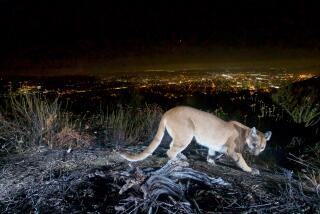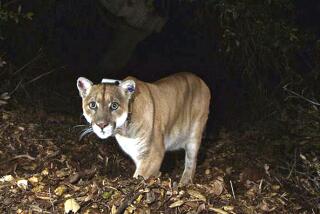Phantom Mountain Lion the Talk of Stanford
PALO ALTO â Nobody has seen the mountain lion believed to have mauled two horses recently on land owned by Stanford University, but the animalâs future was hotly debated last week before school officials declared that they would not seek permission to have it shot.
The April 23 and May 1 horse attacks occurred near a popular campus hiking trail known as the Dish. Both horses are expected to recover, according to California Department of Fish and Game spokesman Steve Martarano.
A university spokesman at first commented in published media reports that perhaps the mountain lion should be shot. The next day, Stanford officials held a news conference to announce that they would not be trying to kill the animal after all. The issue drew attention from student environmental groups.
âI want to make it quite clear: It is our intention not to have firearms on campus,â said Jeff Wachtel, senior assistant to the university president. âWe donât want people being deputized to go out and hunt on our property.â
According to state law, parties directly affected by a mountain lion attack can obtain a depredation permit, which allows them 10 days to kill the suspect animal.
Neither of the owners of the two injured horses will seek the mountain lionâs destruction, according to Martarano.
The entire Stanford campus -- which now includes the university, pastures and a sprawling shopping mall -- was declared a game preserve by the Legislature in 1927. That means that even if the mountain lion were to be hunted, by law it would have to be trapped and euthanized rather than killed with a firearm.
Nobody seems to be avoiding the hiking trail despite security guards posted at the entrance and fliers warning trail users about mountain lions.
In the heart of Palo Alto, Stanford and its environs offer a mix of bustling commerce and bucolic country life. Adjacent to the busy center of campus are glitzy law offices and venture capital firms interspersed with rolling green pastures; often, the roads are thick with bicyclists and horseback riders as well as automobiles.
The first mountain lion attack is believed to have occurred April 23 in a corral near the Dish. A second horse was discovered attacked May 1, after it apparently broke out of a pasture about a mile and a half from the hiking trail. The horse had scratch wounds believed to have been from a mountain lion, but its most serious injuries were cuts from a barbed wire fence.
Investigators recovered hair from the horse and another animal, believed to be a mountain lion, from the fence.
In January, a mountain lion in Orange County killed one bicyclist and injured another in the Whiting Ranch Wilderness Park. Since then, the number of mountain lion sightings reported to the Department of Fish and Game has skyrocketed, Martarano said.
The agency attributes the jump to increased public awareness rather than to any change in mountain lion behavior.
âThere are stories running across the state on a daily basisâ about mountain lions, Martarano said.
For example, two sightings were reported in Anaheim Hills last week, prompting officials to warn residents to use caution when out in open land.
Also known as cougars, panthers or pumas, adult male mountain lions can grow to more than 8 feet long and generally weigh between 130 and 150 pounds. The animals usually hunt alone, at night.
The annual number of mountain lion sightings reported to the Department of Fish and Game averages more than 400, according to information posted on the agencyâs website. Only about 3% of those lead to the determination that an animal poses an imminent threat to public safety and should be killed.
Although sightings are common, it is considered rare and âdisturbingâ for the animals to attack horses, Martarano said. Mountain lions in California generally prey on deer.
Despite the concern generated when mountain lions are active in close proximity to people, Martarano said, the animals are generally considered unlikely to harm humans. In California, there have been only 14 known attacks on humans since 1890, resulting in six fatalities.
âProbably every hiking trail in this state has mountain lions around it. Half the state is considered mountain lion habitat,â said Martarano. In general, mountain lions live wherever deer are present.
Stanford distributed fliers near the trail last week urging caution, and campus security guards were posted at the entrances. But university spokeswoman Elaine Ray said the community didnât seem to be avoiding the steep four-mile trail, which gets its name from two large university-operated satellite dishes there. About 1,600 people use the trail daily.
The fliers advise people not to hike alone, to keep children close and to avoid bending over and crouching. If people spot a mountain lion, they should not run away, experts warn. Running could trigger the animalâs instinct to give chase.
Rather, people who find themselves face to face with such an animal should raise their arms high and try to look larger. If attacked, they should fight back and try to remain as upright as possible. If children are nearby, they should be picked up to appear larger as well.
Joshua Spanogle, a third-year medical student at Stanford who frequently runs on the trail, said he wouldnât be deterred. He said the prospect of encountering a mountain lion seemed more thrilling than scary.
âIf I saw a mountain lion, I think Iâd be scared,â Spanogle said. âIâd probably go the other direction. But it would also be kind of cool too. Iâve never seen a mountain lion.â
More to Read
Sign up for Essential California
The most important California stories and recommendations in your inbox every morning.
You may occasionally receive promotional content from the Los Angeles Times.










